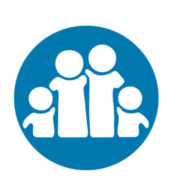Posttraumatic Stress

What is Posttraumatic Stress?
Posttraumatic stress is the lingering effects that may occur in response to witnessing or experiencing a traumatic event(s). In response to a perceived imminent threat, our natural psychological and biological “survival response” is activated. Our sympathetic nervous system kicks into high gear, causing our body to prepare for action. This Flight-Fight-Freeze response causes our muscles to tense, pupils to dilate, heart rate and breathing to increase, digestion to pause, and other survival instincts to take over. Once the perceived threat has subsided, our parasympathetic nervous system activates, helping our body return to a state of rest, relaxation, and balance.
However, it is not uncommon for some people to experience lingering effects after such an experience such as – intrusive thoughts or dreams and/or trying not to think about the traumatic event, increased alertness or hypervigilance, increased worry, difficulty concentrating, changes in sleeping and/or eating habits, and being unable to remember details about the event. But, when symptoms are persistent and cause a change in one’s ability to function, a Trauma-and-Stressor-Related Disorder – such as Adjustment Disorder, Acute Stress Disorder, or PTSD – may be diagnosed.
Common Symptoms/How It Impacts Someone’s Life:
- Frequently feeling as though the traumatic event is still happening; experiencing flashbacks.
- Experiencing panic attacks.
- Being unable to concentrate and getting easily distracted by sensory information (sights, sounds, smells, physical sensations, etc.).
- Having difficulty feeling “safe” or at ease; believing that the world and the people around you are dangerous.
- Avoiding people, places, activities, or conversations that remind you of the traumatic event(s).
- Being frequently “zoned out,” numb, and/or unable to feel anything.
- Missing deadlines, procrastinating, having trouble making decisions, feeling as though things are pointless.
People often realize that their behavior is not ideal and feel terrible that they are struggling to keep up with their usual responsibilities. Guilt, worry and irritability can be part of posttraumatic stress as well. Losing interest in work/school and daily activities can lead to feelings of frustration, worry about the future and guilt about tasks left undone. Sometimes, posttraumatic stress symptoms include self-harm and thoughts of suicide.
What Can Posttraumatic Stress Look Like?

In Crisis
Very anxious / Panic attacks
Very low mood
Talking about suicide
Absenteeism
Exhausted
Very poor sleep
Abusing substances

Struggling
Anxious
Chronically on edge
Depressed
Tired
Poor Performance
Poor Sleep
Negative beliefs about oneself, others, or the world

Surviving
Worried
Nervous
Sad
Trouble Sleeping
Distracted
Withdrawn

Persevering
Fine
Calm
OK
Keeping Up
Rested
Managing

Excelling
Cheerful
Joyful
Energetic
High performance
Flow
Fully realizing potential
Ways to Treat Posttraumatic Stress
There are many helpful treatments for Trauma-and-Stressor-Related Disorders and options for every level of care.
Universal Precautions (things you can do and plan on your own)
• Taking care of getting proper sleep and nutrition
• Minding your physical health (regular check-ups and if applicable, taking prescribed medication)
• Working out/including movement and exercise
• Spending time with friends
• Journaling
• Practicing mindfulness
• Experiencing joy, play and awe
Evidence Based Treatment Options (Reaching out to a trained professional)
• Therapy
◦ EMDR
◦ Cognitive Behavioral Therapy w/a Trauma Focus (CBT-T)
◦ Cognitive Processing Therapy (CPT)
◦ Prolonged Exposure (PE)
◦ Cognitive Therapy (CT)
All therapeutic styles will involve learning about:
◦ the way our brains operate (the stress response system, expected cognitive impairments when we are under stress),
◦ the symptoms of posttraumatic stress and ways to address and shift them,
◦ the way that thoughts, feelings and behaviors are linked and influence each other.
◦ most therapeutic styles involve exploring without judgment one’s feelings, beliefs, thoughts, and habits in an effort to reframe /expand awareness /experiment with ideas.
This allows the thoughts, feelings and behaviors to change and influence each other in new ways. Therapy also involves learning about and practicing strategies and coping habits that support wellbeing.
• Medications –there are some medication options that have shown some benefit in reducing posttraumatic stress symptoms.
If you or someone you know is in Crisis and unable to perform daily activities:
Symptoms may be or become overwhelming and prevent a person from engaging in many of the above interventions. People who are in crisis may require a more intensive treatment plan. When this is the case, call a professional as soon as possible. What happens next might include:
- Health and Safety Assessment (HSA)—people experiencing a crisis may benefit from a structured interview with a mental health clinician to assess the threats to their wellbeing and provide recommendations regarding seeking treatment.
- Partial Hospitalization Programs (PHPs)
- Intensive Outpatient Programs (IOPs)
If you or someone you know is in Danger of harm (Immediately call 9-1-1 or go to a crisis-trained organization)
• Emergency Room Hospitalization. Dial 9-1-1 or proceed to your nearest emergency room if you or someone you are with is in imminent danger of harm.
Resources
The National Child Traumatic Stress Network (NCTSN)
https://www.nctsn.org/audiences/families-and-caregivers
International Society for Traumatic Stress Studies
https://istss.org/public-resources
American Psychological Association
https://www.apa.org/ptsd-guideline/treatments/
National Institute of Mental Health
https://www.nimh.nih.gov/health/publications/ptsd-listing

